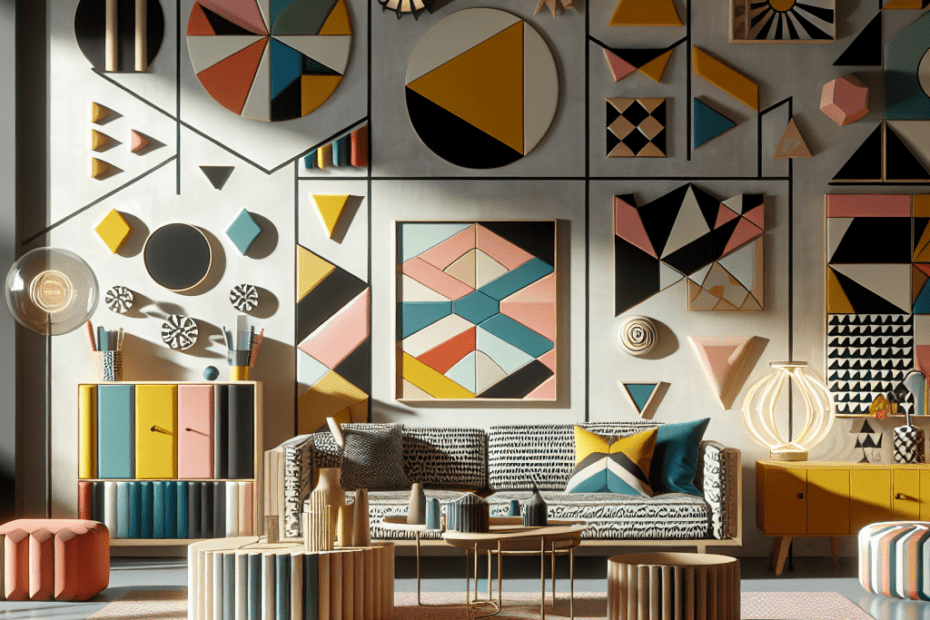How to Use Geometric Patterns in Eclectic Spaces
When people think about eclectic design, they often imagine a mix of different styles coming together to make a unique and harmonious space. By adding geometric patterns to this blend, designers can add boldness and complexity to their designs. Geometric patterns are not only visually striking, but they also offer a sense of order in the midst of the creative chaos that defines eclectic spaces.
Understanding Geometric Patterns
Geometric patterns are shapes and forms consisting of lines, circles, rectangles, and triangles. These shapes can be arranged in regular or irregular ways. They are widely used because of their versatility. According to a report by Decor Aid, over 20% of interior designers incorporate geometric patterns into their eclectic designs, illustrating their popularity and flexible nature.
The Appeal of Geometric Patterns in Eclectic Design
Whether it’s a bold wallpaper, an intricately woven rug, or a piece of artwork, geometric patterns can balance out an eclectic room by giving it structure. Design experts say that the use of these bold patterns adds an eye-catching focal point and visual interest, without overcrowding the space.
Implementing Geometric Patterns
Use geometric patterns strategically. Too many bold patterns in one area can make the room feel busy. Instead, they should be used to highlight a specific section of a room. Mixing patterns and experimenting with color will enhance this effect further.
- Walls: Use geometric-patterned wallpapers or paint to create accent walls.
- Rugs: Select rugs with bold geometric designs that complement existing color schemes.
- Decor: Use geometric-patterned cushions or throws to tie the whole room together.
Choosing the Right Patterns
Consider the size of the room and existing decor when selecting geometric patterns. Large, bold patterns can make a small room feel smaller, so they are best used sparingly in compact spaces. For larger rooms, they can be used more freely, sometimes even serving as the primary design element. An analysis by Houzz suggests that about 15% of homeowners report using geometric patterns as a key part of their eclectic decor because of their effectiveness in anchoring wide spaces.
Combining Geometric Patterns
Combining different patterns can result in a harmonious yet eclectic look, but matching scales and colors is crucial. Complementary color schemes often work best. By using a combination of small and large patterns, occupants can create a layered and dynamic aesthetic.
| Elements | Usage Percentage |
|---|---|
| Walls | 40% |
| Rugs | 35% |
| Decor | 25% |
Precautions with Geometric Patterns
It’s essential to balance geometric patterns with solid colors to ensure the room doesn’t look chaotic. If the patterns are too dominant, they may detract from other design elements. Using neutral tones and simple furniture can prevent this from happening. Lighting also plays a vital role. Proper lighting enhances the geometric shapes and colors, adding depth and dimension.
Conclusion
Incorporating geometric patterns in eclectic spaces can elevate the overall design and draw attention to accents within the mix of styles. With the right balance, these patterns add an element of visual interest and playfulness, transforming ordinary spaces into dynamic works of art. When carefully arranged, geometric patterns contribute a touch of modernity to the eclectic design’s broad canvas, tying different elements together with elegance and flair.
Key Takeaways
- Geometric patterns add structure and visual intrigue to eclectic spaces.
- Use them sparingly in small rooms to avoid overwhelming the space.
- Combine patterns with similar colors for a cohesive look.
- Avoid overusing patterns to prevent a chaotic appearance.
- Balanced lighting enhances the effects of geometric patterns.
FAQ
- What are geometric patterns?
Geometric patterns consist of repeating shapes such as lines, circles, and triangles used in various arrangements.
- Why use geometric patterns in eclectic design?
They add structure and a focal point to the space, enhancing the visual interest and balance of eclectic design.
- Can geometric patterns be combined with other designs?
Yes, but matching scales and color palettes is essential for a cohesive look.
- How to keep the balance with bold geometric patterns?
Pair them with neutral tones and solid colors to avoid a chaotic appearance.
- What elements can incorporate geometric patterns?
Walls, rugs, decor, and even furniture can incorporate geometric patterns to enhance eclectic design.
